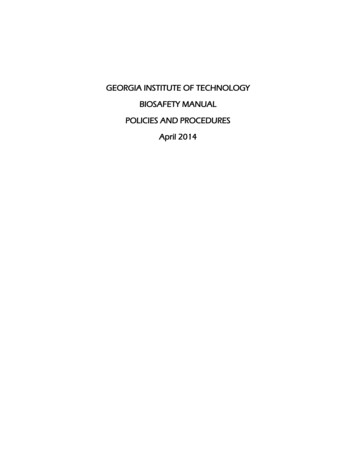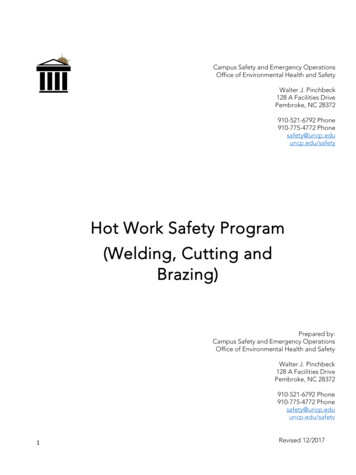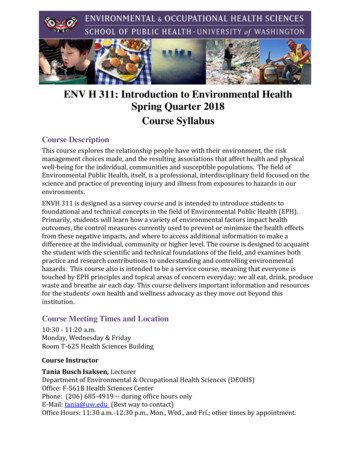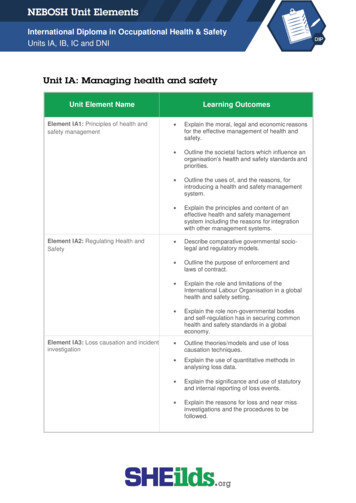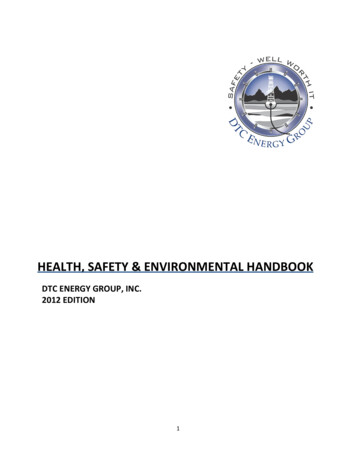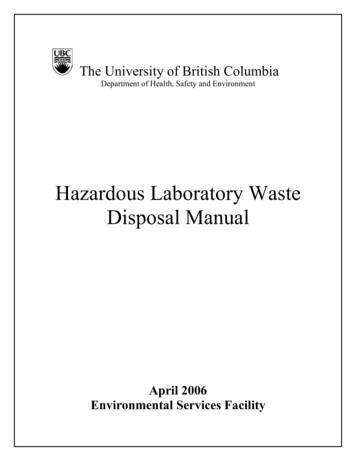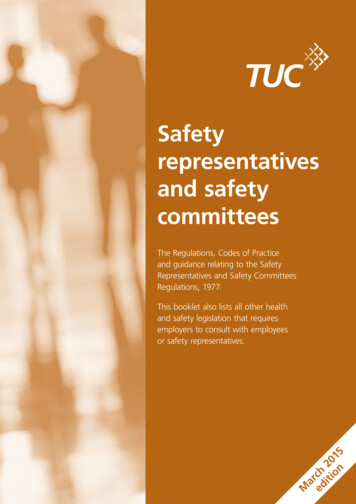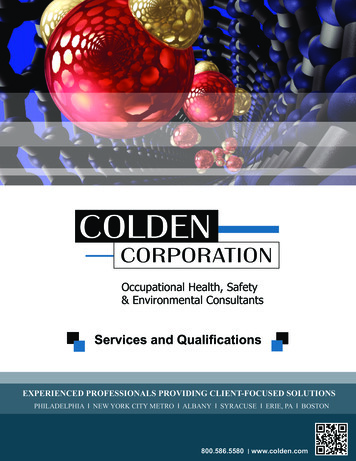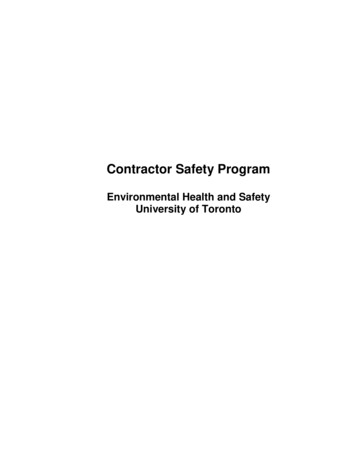
Transcription
Contractor Safety ProgramEnvironmental Health and SafetyUniversity of Toronto
Contractor Safety ProgramTable of ContentsDefinitions . 3Overview . 5Introduction to Contractor Safety . 6Scope. 6Roles and Responsibilities . 7Responsibility of Environmental Health and Safety . 7Responsibilities of Hazardous Construction Materials Group (St. Georgeonly) . 7Responsibilities of University of Toronto Project/Work Coordinator (e.g.Property/Project Manager, Department Supervisor) . 7Responsibilities of Construction, Maintenance & Contractor Supervisors . 8Responsibilities of Workers . 8Program Elements . 9Hazard Identification & Communication . 9Project/Work Safety Acknowledgement . 9Contractor Prequalification . 9Contractor Disqualification . 10Training . 10Safety Meetings & Site Inspections . 10Notification & Permits . 10Personal Protective Equipment . 12Subcontractors . 12Waste . 13Incident, Accident, Occupational Disease Reporting. 13Program Audit & Review . 15Disclaimer . 15Appendix . 15Construction/Maintenance/Contractor Safety ProgramUniversity of TorontoJune 2015Page 2 of 15
Contractor Safety ProgramDefinitionsOCCUPATIONAL HEALTH & SAFETY ACT (R.S.O. 1990, CHAPTER O.1) DEFINITIONS:“competent person” means a person who,(a) is qualified because of knowledge, training and experience to organize the work andits performance,(b) is familiar with this Act and the regulations that apply to the work, and(c) has knowledge of any potential or actual danger to health or safety in the workplace;“construction” includes erection, alteration, repair, dismantling, demolition, structuralmaintenance, painting, land clearing, earth moving, grading, excavating, trenching,digging, boring, drilling, blasting, or concreting, the installation of any machinery or plant,and any work or undertaking in connection with a project but does not include any work orundertaking underground in a mine; (“construction”)“constructor” means a person who undertakes a project for an owner and includes an ownerwho undertakes all or part of a project by himself or by more than one employer;“designated substances” are the following chemical agents prescribed as designatedsubstances: Acrylonitrile, Arsenic, Asbestos, Benzene, Coke oven emissions, Ethyleneoxide, Isocyanates, Lead, Mercury, Silica and Vinyl chloride;“employer” means a person who employs one or more workers or contracts for the services ofone or more workers and includes a contractor or subcontractor who performs work orsupplies services and a contractor or subcontractor who undertakes with an owner,constructor, contractor or subcontractor to perform work or supply services;“owner” includes a trustee, receiver, mortgagee in possession, tenant, lessee, or occupier ofany lands or premises used or to be used as a workplace, and a person who acts for or onbehalf of an owner as an agent or delegate;“project” means a construction project, whether public or private, including,(a) the construction of a building, bridge, structure, industrial establishment, mining plant,shaft, tunnel, caisson, trench, excavation, highway, railway, street, runway, parkinglot, cofferdam, conduit, sewer, watermain, service connection, telegraph, telephoneor electrical cable, pipe line, duct or well, or any combination thereof,(b) the moving of a building or structure, and(c) any work or undertaking, or any lands or appurtenances used in connection withconstruction;“supervisor” means a person who has charge of a workplace or authority over a worker;Construction/Maintenance/Contractor Safety ProgramUniversity of TorontoJune 2015Page 3 of 15
Contractor Safety ProgramOTHER PERTINENT DEFINITIONS APPLICABLE TO THIS PROGRAM:“construction project” is work falling under the Construction Projects Regulations (O.Reg.213/91)of the Occupational Health and Safety Act. In addition to description of “Construction” and“Projects” in the above section, the following may also be considered to be construction projectsand require Notice of Projects to be submitted to MOL before work begins:(a) the total cost of labour and materials for the project is expected to exceed 50,000;(b) the work is the erection or structural alteration of a building more than two storeys ormore than 7.5 metres high;(c) the work is the demolition of a building at least four metres high with a floor area of atleast thirty square metres;(d) the work is the erection, structural alteration or structural repair of a bridge, an earthretaining structure or a water-retaining structure more than three metres high or of asilo, chimney or a similar structure more than 7.5 metres high;(e) work in compressed air is to be done at the project;(f) a tunnel, caisson, cofferdam or well into which a person may enter is to be constructedat the project;(g) a trench into which a person may enter is to be excavated at the project and the trenchis more than 300 metres long or more than 1.2 metres deep and over thirty metres long;or(h) a part of the permanent or temporary work is required by this Regulation to be designedby a professional engineer. O. Reg. 213/91, s. 6 (1).“Project/Work Coordinator” means a competent person who,(a) is responsible for planning, coordinating and meeting the objectives of constructionprojects(b)is typically a Project Manager or a Property Manager, but can be any universityemployee who hires contractors to conduct maintenance work“building contact” means a competent person who,(a) is responsible for managing or maintaining university buildings, building systems orprograms, who belong to:a.St. George: Property Management, Fire Prevention (Fire), Utilities & BuildingOperationsb.Mississauga: Facilities Management & Planning (Fire), Student Housing &Residence Lifec.Scarborough: Facilities Management, Security, Fire & Parking (Fire), StudentHousing & Residence LifeConstruction/Maintenance/Contractor Safety ProgramUniversity of TorontoJune 2015Page 4 of 15
Contractor Safety ProgramOverviewUniversity of Toronto is a complex workplace with a large array of environmental andoccupational health & safety hazards (e.g. chemical, biological, radiation, physical,asbestos, etc.). There are various stakeholders at the University of Toronto – SeniorManagement, Faculty, Managers, Supervisors, Workers, Contractors, etc., that haveresponsibilities and accountabilities under the Occupational Health and Safety Act.Although contractors are not employees of University of Toronto, the OccupationalHealth and Safety Act still requires that contractors and constructors doing work for theUniversity of Toronto be accountable to requirements of the Occupational Health andSafety Act (and regulations) and thus protect their workers while working on Universityproperty. Additionally, contractors and constructors must ensure that their work does notendanger the health and safety of the University community.It is therefore the University’s objective to:- select, hire and work with only competent contractors who conform to theOccupational Health and Safety Act of Ontario.- ensure internal work departments are competent who conform to theOccupational Health and Safety Act of Ontario.- ensure that external contractors and internal work departments are made awareof their obligations under the Ontario Occupational Health and Safety Act (andregulations) as well as the University’s Environment, Health and Safetyrequirements, safety standards and procedures.- provide information on known hazards on University premises, as they relate tothe construction/work site;All contractor and University supervisors must ensure that each of their workers whoappear on site to perform work:- are made aware of their responsibilities, and abide by the University’sEnvironment, Health and Safety requirements, safety standards and procedures;- are made aware of any known hazards at the university workplace and reportunsafe situations or safety incidents to their line management;- are trained and qualified in the work they perform and are instructed in the safetyprocedures to be followed to avoid these hazards, and;- are working safely and are taking all necessary actions and precautions toprotect themselves and the University community and property.Construction/Maintenance/Contractor Safety ProgramUniversity of TorontoJune 2015Page 5 of 15
Contractor Safety ProgramIntroduction to Contractor SafetyWork falling under the Construction Projects Regulations (O.Reg.213/91) of theOccupational Health and Safety Act. Please refer to the definitions section fordescription of “Construction” and “Projects”.Every construction project has both an owner and a constructor. The constructor hasspecial meaning under the Occupational Health and Safety Act and will either be theowner of the project or an external company contracted by the owner to undertake theproject for the owner.When the University hires an external contractor, as a sole contractor on a constructionsite – that contractor becomes the “constructor”. The constructor may hire othercontractors called “sub-contractors” and remain a constructor.When multiple contracts to the University on one construction site are implemented,providing that each contractor is separated by time and space, the University will notbecome the constructor. Separation requires a physical separation or barrier as well asseparate access times (e.g. different shifts). The owner may also engage the services ofa professional engineer, an architect, or another person (Prime Consultant) solely tooversee the quality control of the project without becoming the constructor.Work falling under the Industrial Establishments Regulations (O.Reg.851) and WindowCleaning Regulations (O.Reg.859) of the Occupational Health and Safety Act areoutside the definition of a construction project. Descriptions of “Construction”, “Projects”and “Construction projects” are specified in the definition section. For more informationabout the definition of construction projects vs. maintenance work, please contact EHS.ScopeThis program covers all construction, maintenance and professional activities conductedby external contractors for the university that poses higher risk than a visitor to theuniversity and situations where a University department is bidding against externalcontractors for a project.Construction/Maintenance/Contractor Safety ProgramUniversity of TorontoJune 2015Page 6 of 15
Contractor Safety ProgramRoles and ResponsibilitiesResponsibility of Environmental Health and Safetya) Prepares a Contractor Safety program and oversees the establishment ofprocesses to implement the contractor safety programb) Ensures hazard information are provided to University of Toronto Project/WorkCoordinator when requested (Appendix B – Contractor Safety Acknowledgementform)c) Provides consultation on designated substances and complex hazards asapplicable.Responsibilities of Hazardous Construction Materials Group (St. Georgeonly)a) Consults on designated / hazardous substances such as Asbestos, Lead andSilica. Provides designated substances report with written description of thehazards including type, location, classification of hazards type and removalmethod; andb) Provides assistance and oversight on projects which require designatedsubstance removalResponsibilities of University of Toronto Project/Work Coordinator (e.g.Property/Project Manager, Department Supervisor)a) Functions as the primary contact for the contractor/constructor for safety issuesor concerns that may arise during the tenure of the contract.b) Ensures that external contractors and university work departments are madeaware of specific hazards at the University.c) Ensures the contractor/constructor selected for the project/work are pre-qualifiedfor the specified scope of work and ensures that the contractor/constructor andhelps to ensure the contractor/constructor performs work within the specifiedscope.d) Participates in the exchange of information between the University and theexternal contractor. Ensures designated substances report is given to thecontractor as per Section 30, subsection 1-3 of the OHSA. Ensures that theexternal contractor is aware of the requirement to report incidents andemergencies to the University by using the on-line incident form for Students,Contractors and Visitors which can be found at www.ehs.utoronto.cae) Communicates safety/shutdown notices as well as negative impacts (such asroof tarring, noise, rerouting) to relevant parties (e.g. including buildingoccupants, EHS staff, building and key contacts)Construction/Maintenance/Contractor Safety ProgramUniversity of TorontoJune 2015Page 7 of 15
Contractor Safety Programf) In the circumstances where external contractor will be using Universityequipment (e.g. aerial lift), must coordinate with equipment owning departmentand ensure the equipment to be rented to the contractor during the work/projectare properly maintained and inspected as per manufacturer’s guidelines andapplicable legislation/standards.Responsibilities of Construction, Maintenance & Contractor Supervisorsa) Be aware of and comply with the Ontario Occupational Health and Safety Actand regulations;b) Employ competent supervisors and trained workers as defined in the OHSA;c) Supply all personal protective equipment, emergency equipment (e.g. First aidkits, fire extinguishers) for their employees, including tools and equipment ingood working order;d) Unless specific permission is provided, the external contractor will not useUniversity of Toronto equipment or tools or emergency equipment such as firstaid kits or fire extinguishers;e) If permission is obtained to use university equipment (e.g. aerial lift), mustensure employees are trained and qualified to use the specific equipment;f) Provide appropriate documentation to the UofT contact as requested (such asan assurance to the Project/Work Coordinator that all equipment that is used onUniversity property is in good working order);g) Ensure the Contractor Safety Acknowledgement form is completed and alldocuments required are submitted to the UofT Contacth) Administer permits, and shut down notices and/or notify or coordinate throughProject/Work Coordinator as appropriate. Discuss work conditions and safety asagenda items at all safety meetings;i) Monitor health and safety compliance and performance.Responsibilities of WorkersWorkers in general, regardless of whether they are employees of the University,Contractor or Sub-contractors must at a minimum fulfill Responsibilities of Workers asdefined in the Occupational Health and Safety Act, which includes and not limited to:a) Not expose themselves to any condition that may endanger themselves, or anyother worker, visitor or guest;b) Promptly report any unsafe act or condition and any environmental or safetyincident or concern that they may become aware of to their supervisor;c) Not proceed with any work, or operate any equipment for which they have notreceived proper training;d) Conduct themselves in a safe, respectful, and orderly manner at all times whileon U of T property, and;e) Understand and comply with all relevant safety regulations, codes, procedures,standards and policies.Construction/Maintenance/Contractor Safety ProgramUniversity of TorontoJune 2015Page 8 of 15
Contractor Safety ProgramProgram ElementsThis program has three main components:1. Contractor Safety Program2. Contractor Safety Flowchart3. Contractor Safety Acknowledgement FormHazard Identification & CommunicationPrior to the tender/procurement during the planning process, the Project/WorkCoordinator must consult with all relevant parties (e.g. Environmental Health & Safety,Occupants, Hazardous Building Materials (for St. George), Building Contacts, ExternalConsultants, etc.) to identify possible hazards to the contractors as a result of theuniversity environment, university employees and community as a result of thescheduled work. Construction/Maintenance/Contractor Safety Acknowledgement form isused to identify hazards and control measures associated with each step. All hazardsmust be communicated using the Contractor Safety Acknowledgement form tocontractors so that hazard controls are factored into the work quote and proposal.During planning, construction, scheduling, duration and process for hazardous work ismonitored by the Project/Work Coordinator who will inform appropriate groups when thework is to be carried out and work with the different stakeholders to ensure safety of theuniversity community.Project/Work Safety AcknowledgementAfter the contractor safety form is used by the project/work coordinator to identifypossible hazards to the contractors/work department as a result of the universityenvironment, the form is given to the contractor/work department supervisor to complete.All sections must be filled out and will be reviewed by the project/work coordinator. Onlywhen the project/work coordinator is satisfied with all answers given by thecontractor/work department, should the project/work coordinator organize the pre-startmeeting with the contractor/work department supervisor.Contractor PrequalificationContractors that conduct routine work for the university within a defined work scope canbe prequalified annually to be part a pre-approved contractor list.For more complex projects or work involving multiple work parties, the contractor safetyacknowledgment form must be filled out for each project or work.Construction/Maintenance/Contractor Safety ProgramUniversity of TorontoJune 2015Page 9 of 15
Contractor Safety ProgramContractor DisqualificationContractors that have repeatedly demonstrated an inability to provide sufficientinformation for Contractor Safety Acknowledgment and/or an inability to maintain healthand safety of the university community may be disqualified from further work.Traininga) Competent Workersa. Each party involved in a construction project or maintenance work mustensure its workers meet the definition of a “Competent Person” asdefined by the Occupational Health and Safety Actb. The Contractor shall produce upon request “proof of competency”, whichincludes but is not limited to training certificates.Safety Meetings & Site InspectionsAt the initial construction meeting after the work has been awarded, the Project/WorkCoordinator will review the information of the contractor safety acknowledgement formand related health and safety issues with the contractor/work department supervisor andensure all information is completed and understood by the contractor/work departmentsupervisor. The contract/work department and project/work coordinator will co-sign theform after all information on the form are discussed, agreed upon and understood. Theproject/work coordinator will request regular updates on general health and safety on thesite. Project/Work Coordinator will provide direction for appropriate processes andcontacts in order to facilitate the work in a timely and safe manner. University contactsshould be supplied with the contractors’ safety meeting minutes and safety inspections.If an unsafe work practice is noted during a routine site visit or noted by a universityemployee, the Project/Work Coordinator must be notified, who will immediately notify thecontractor responsible for the site and request resolution. Depending on the hazard, theProject/Work Coordinator may request that work is stopped pending notification of thecontractor and/or other personnel.Notification & PermitsBefore the start of a project/work, notification requirements must be sorted out by theproject/work coordinator in conjunction with the contractor/work department supervisor.The Contractor Safety acknowledgement form must be used to identify basic notificationand permit requirements. A copy of the contractor safety acknowledgement form mustbe forwarded to EHS and the appropriate building contact (e.g. Property Management,Facilities Management, etc.).Construction/Maintenance/Contractor Safety ProgramUniversity of TorontoJune 2015Page 10 of 15
Contractor Safety ProgramInternal permitsInternal permits and systems shutoff forms must be obtained for the high risk work (e.g.hot work, confined space entry, shutoff of fire, HVAC and water systems). If the workoccurs on UofT premise during operation, they must be coordinated through theproject/work coordinator. If the work occurs within a construction site separated fromUofT operations, the constructor would administer the permit systems. For laboratoryprojects or work, the UofT lab design standard and laboratory space decommissioningprocesses must be followedExternal permitsA Notice of Project to the Ministry of Labour is required if: The project has a total cost of labour and materials expected to exceed 50,000;The work is the erection or structural alteration of a building more than twostoreys or more than 7.5 metres high;The work is the demolition of a building at least 4 metres high with a floor area ofat least 30 square metres;The work is the erection, structural alteration or structural repair of a bridge, anearth-retaining structure or a water-retaining structure more than 3 metres high orof a silo, chimney or a similar structure more than 7.5 metres high;Work in compressed air is to be done at the project;A tunnel, caisson, cofferdam or well into which a person may enter is to beconstructed at the project;A trench into which a person may enter is to be excavated at the project and thetrench is more than 1.2 metres deep; orA part of the permanent or temporary work is required by this Regulation to bedesigned by a professional engineer.Posting and additional notification requirements The constructor/employer must print a copy of the Notice of Project, sign andpost it at the project or make it available at the project for review by a Ministry ofLabour inspector.Estimated cost of labour and materials, including the labour and materials of allsub-contractors must be entered where required.Contact the MOL office nearest the project to notify the Ministry and to obtainyour Notification Number prior to starting the operation for projects involving:o Trenching more than 1.2m;o Multi-tiered lifts as defined by section 103.1 of the Regulation;o Use of cranes to lift workers (section 153 (11));Construction/Maintenance/Contractor Safety ProgramUniversity of TorontoJune 2015Page 11 of 15
Contractor Safety ProgramoooDismantling of multi-point suspended scaffolds;Window cleaning (where workers may fall a vertical distance of threemetres or more, or if prior to carrying out window cleaning work at abuilding in Ontario if a suspended scaffold, boatswain’s chair or similarsingle-point equipment is to be used); orType 3 asbestos operations and type 2 asbestos glove bag removals ofless than one square metre.Note: In case of an emergency the work at the project may be started if the informationrequired is provided to the Ministry by phone or by fax. For details please refer toSection-6(5) of Ontario Regulation-213/91 for construction projects. In emergencysituations, the UofT project/work coordinator must be notified.Personal Protective Equipment--University of Toronto supplies personal protective equipment for its ownpersonnel. External contractors are responsible for providing personal protectiveequipment for their own personnelAll personnel are responsible for proper use of personal protective equipment incircumstances required by law or as a result of hazardous conditionsSupervisory personnel are responsible for ensuring that users of personalprotective equipment have adequate knowledge of proper use, care, inspection,maintenance and limitations of the equipment.Usage of University of Toronto EquipmentContractors are expected to use their own equipment, tools and materials to conductwork at the university. However, in rare circumstances, UofT equipment must be used bycontractors to conduct the work. In these cases, contractor must identify this need on theContractor safety acknowledgement form and must obtain approval from theproject/work coordinator ahead of time. The contractor must ensure their employees whowill be using the machine be qualified and trained to use the specific equipment safely.The validity of the equipment operation certifications will be verified by the project/workcoordinator. The project/work coordinator must ensure the equipment to be used by thecontractor is in good working order and maintained as per manufacturers and anyapplicable legislation and standards.SubcontractorsContractors hiring sub-contractors to work at the University are fully responsible forensuring the health and safety of the sub-contractors and the university community as aresult of the work. Contractors must have a contractor safety management program toensure they are hiring competent sub-contractors that would follow all applicable healthConstruction/Maintenance/Contractor Safety ProgramUniversity of TorontoJune 2015Page 12 of 15
Contractor Safety Programand safety legislation, standards, university procedures and general contract conditions.Examples of sub-contractor requirements: Unionized sub-trades, valid WSIB coverage,adequate liability insurance coverage and trained and qualified employees.Waste-All waste generated at the project/work is the responsibility of the contractor/workdepartment. Supervisors must ensure waste are disposed of according toapplicable legislation and university procedures.Incident, Accident, Occupational Disease Reporting1. Reporting Injuries and occupational Illnesses An“occupational illness” is defined as a condition that results from exposure in aworkplace to a physical, chemical or biological agent to the extent that the normalphysiological function of the worker is impaired. It includes an occupational disease forwhich a worker is entitled to benefits under the Workplace Safety and Insurance Act,1997. Any employee suffering an injury or occupational illness at a university workplace orjob site must report the injury / illness to his / her supervisor as soon as practicable. Allnon-employees involved in an incident/accident must report the event to aUniversity of Toronto contact. Within 24 hours, the University of Toronto contact mustcomplete and submit the "Online Accident/Incident Report for Students, Contractors, andVisitors." -visitors/ Firstaid should be sought and provided if necessary. Ifthe worker requires emergency medical care call 9-1-1 and/or Campus Police,describe the need, and request an ambulance.2. Reporting Workplace Critical Injuries or Fatalities A“critical injury” is an injury that, places life in jeopardy, produces unconsciousness, results in substantial loss of blood involves the fracture of a leg or arm involves consistsbut not a finger or toe,the amputation of a leg, arm, hand or foot but not a finger or toe,of burns to a major portion of the body, orConstruction/Maintenance/Contractor Safety ProgramUniversity of TorontoJune 2015Page 13 of 15
Contractor Safety Program causesthe loss of sight in an eye. Ifa person has been critically injured or killed at the workplace, the employer mustimmediately notify an inspector at the nearest Ministry of Labour office, and the jointhealth and safety committee or health and safety representative (if any). Notification ofthe Ministry of Labour must be by direct means, such as by telephone, telegram orfacsimile. Within 48 hours, the employer must also notify, in writing, a Regional Directorof the Ministry of Labour, giving the circumstances of the occurrence. If the injuredemployee is a UofT employee, EHS must be notified and EHS will notify the MOL. If theemployee is an external contractor/sub-contractor employee, the employer must notifyMOL, Campus Police and the UofT Contact person. Whena critical injury occurs, one must:a. Ensure that there is no further danger in and around the incident scene.b. Ensure that the injured, other workers and public are prote
and "Construction projects" are specified in the definition section. For more information about the definition of construction projects vs. maintenance work, please contact EHS. Scope This program covers all construction, maintenance and professional activities conducted
